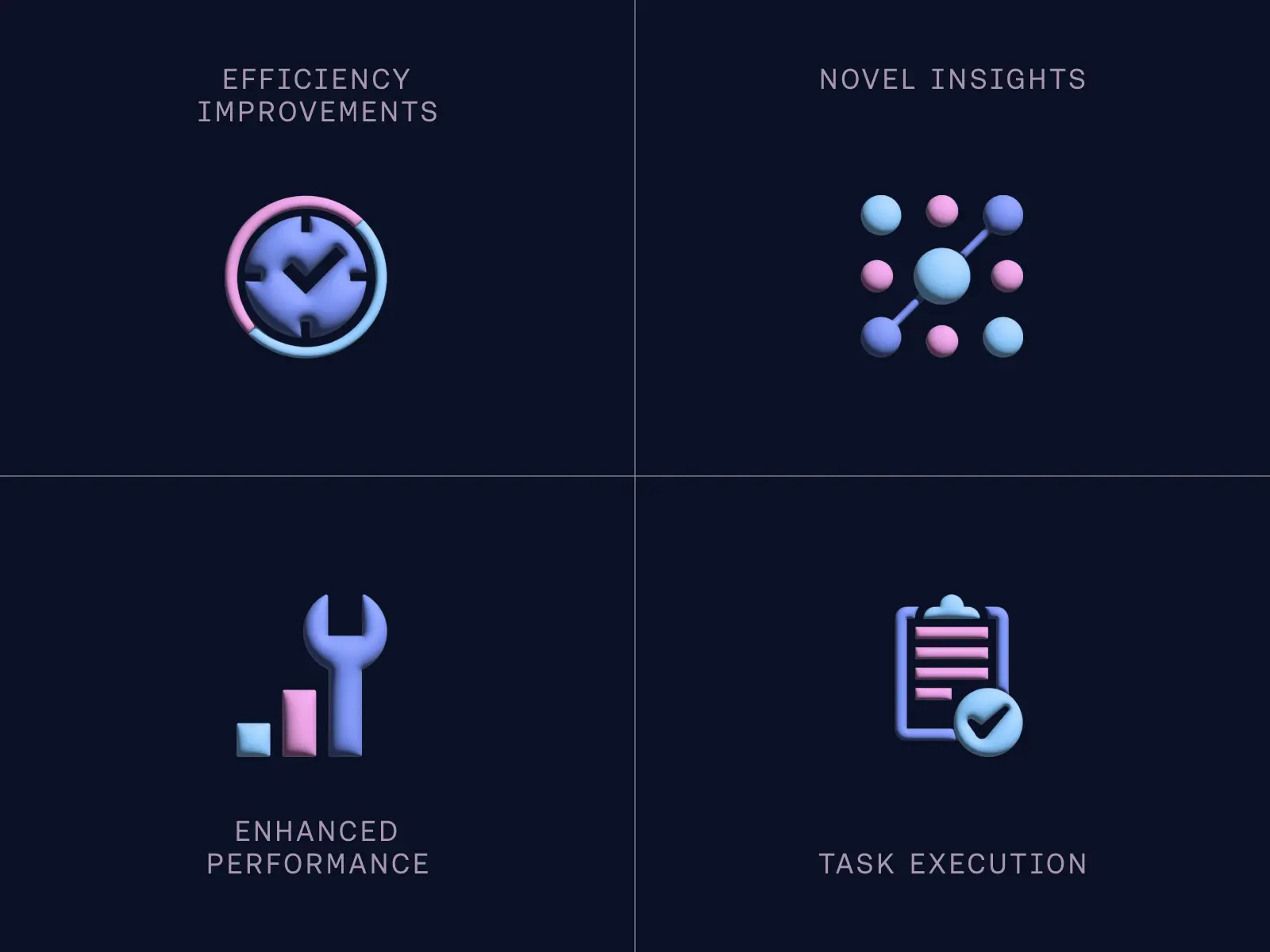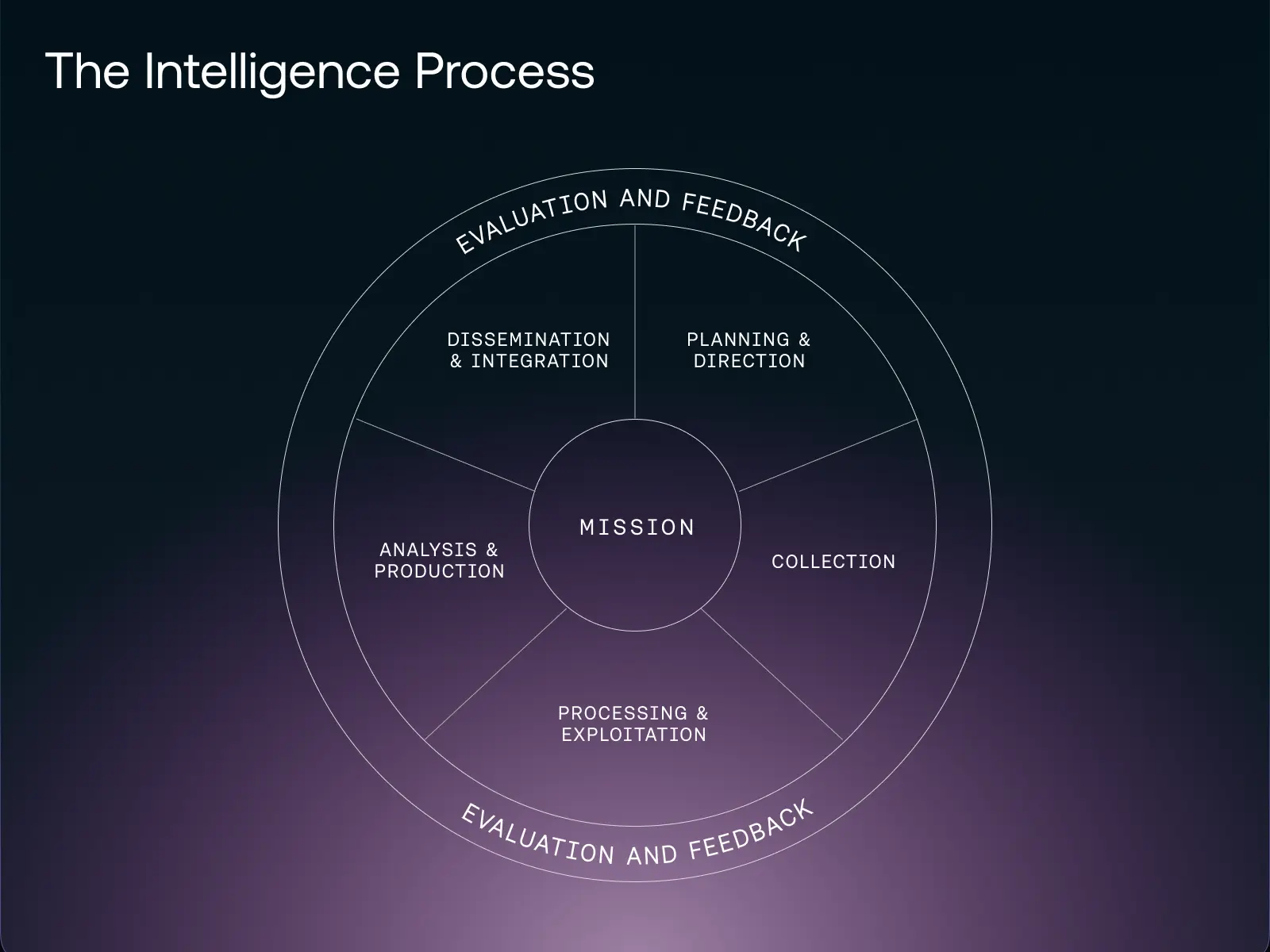Guide to AI for the Intelligence Community
This guide covers applications of artificial intelligence for the Intelligence Community.
Introduction
Intelligence continues to act as a crucial lever that provides a superior knowledge advantage for national and homeland security. Technology is paramount to securing and maintaining a competitive edge. One of the goals in the latest National Intelligence Strategy from the Office of the Director of National Intelligence specifically outlines that the Intelligence Community (IC) needs to deliver interoperable and innovative solutions at scale by leveraging state-of-the-art technology deliberately, lawfully, and ethically.
Given the recent breakthroughs in generative artificial intelligence (AI) and large language models (LLMs), the Intelligence Community is considering how to take advantage of these new capabilities to detect, assess, disrupt, and defeat threats to the United States. The U.S. government’s initiative to adopt generative AI is already in motion. Last year, the Department of Defense established a generative artificial intelligence task force to assess, synchronize, and employ generative AI capabilities across the department. Soon after, President Biden issued an executive order on the safe, secure, and trustworthy development and use of artificial intelligence. Following the Executive Order, the Department of Defense and the Defense Intelligence Agency (DIA) both released an AI Strategy.
In this guide, we will dive deeper into the importance and benefits of AI, explore essential use cases, and provide insights on effectively implementing AI within the Intelligence Community. You will gain a comprehensive understanding of how AI can be harnessed to enhance intelligence operations and the decision-making processes.
AI for Intelligence: Why is it Important?
Why are recent advancements in generative AI significant? Generative AI and large language models are unique in their ability to understand and generate data across a variety of different modalities including text, image, video, and audio. These innovations offer an unprecedented level of human-like intelligence and capabilities. For the Intelligence Community, AI can act as a force multiplier for your staff. Case in point, Lakshmi Raman, Chief Artificial Intelligence Officer at the CIA, mentioned that “it’s very important that when we’re using AI systems to collaborate with our officers, we make sure their tradecraft is incorporating this new, sometimes novel technology.”
A few benefits of AI for intelligence include:
Improved Efficiency: AI can process and ‘understand’ the content and context contained within thousands of documents. Such documents include classified intelligence reports, historical briefings, open source intelligence (OSINT) such as leaked datasets, signals intelligence (SIGINT) such as encrypted messages, geospatial intelligence (GEOINT) such as synthetic aperture radar imagery, and much more. AI leverages advanced algorithms to process large volumes of data in minutes, whereas humans can typically read around 250 words per minute. AI can also assist with tasks associated with reading comprehension. Intelligence analysts can use AI to quickly gather context across a large corpus of information, conduct analysis including named entity recognition, and semantic relationship mapping.
Enhance Performance: AI uses algorithms and models to make deterministic and probabilistic predictions that rival and can outperform the speed of human analysis. For example, as part of Project SABLE SPEAR executed by the Defense Intelligence Agency (DIA), a project team worked with a startup to expose an illicit network responsible for the global tracking of fentanyl using AI. Using AI to explore DIA and open-source datasets, the company’s AI methods identified 100 percent more companies engaged in illicit activity, 400 percent more people so engaged, and counted 900 percent more illicit activities. As referenced in the DIA’s Lessons Learned, “the AI approach identified analytically relevant variables that our analysts probably would never have come up with and made instantaneous associations for those variables across multiple, often complex, data sets.”
Novel Insights: The amount of data being generated on a daily basis is already exceeding humans’ capacity to consume, process, and make informed decisions at lightning fast speeds. AI can provide exhaustive analysis and surface data that could be overlooked to assist intelligence units with analytical processes, such as preparing a Joint Intelligence Preparation of the Operational Environment (JIPOE).
Task Assistance: Intelligence units are constrained by manpower, time, and resources. Tasks such as daily briefings can be manual, cumbersome, and result in bottlenecks to information sharing. Generative AI capabilities can accelerate and even automate repetitive tasks. Analysts can use AI to take a first pass at writing a SITREP in the format and tone necessary, while including the information end users need. Analysts can provide feedback to a model to improve performance and refine writing capabilities to meet specific forms and styles.

AI in the Intelligence Community: Use Cases
There are a number of different use cases for AI in Intelligence. In this guide, we will focus on how AI can assist with the intelligence cycle. These operations aim to provide policymakers, military leaders, and other senior government leaders with relevant and timely intelligence. These practices are followed by independent agencies including the ODNI and CIA as well as intelligence elements of other departments and agencies including Department of Treasury, Department of State, Department of Justice, and Homeland Security can explore similar use cases for Intelligence Cycles. Similar practices like intelligence operations for the Joint Intelligence Process are followed by DOD intelligence units.

Planning and Direction
Intelligence officers conduct planning exercises to allocate resources for operations. This includes defining priority intelligence requirements (PIR) and request for information (RFI) management for Intelligence, Surveillance, and Reconnaissance (ISR). Planning requires continuous evaluation, assessment, and updating PIR for intelligence needs.
It is a time and labor intensive process to develop a PIR that prioritizes asset collection and analyzes resources in order to synchronize intelligence assets for a mission. Tactically, this can entail intelligence staff collecting information across cross-functional units like cyber and information operations to define requirements, specifying priorities, and developing and refining tasking requirements. Generative AI can help streamline the drafting process by automating the assembly of comprehensive and precise requirement documents and ensuring alignment with military standards and operational objectives. Products like Scale Donovan enable intelligence units to upload documents that will inform requirements, leverage LLMs to triage historical requirements, and rapidly convert new information to actionable requirements.
Using Scale Donovan, intelligence organizations can develop exhaustive requirements for downstream units to produce decision-ready intelligence products. Generative AI capabilities can accelerate PIR creation and transform information to intelligence with predictive and timely analysis.
Collection
A variety of different mediums can be used to capture information. Methods vary from satellite surveillance, human sources, communication or electronic transmission, and open-source platforms like the Internet or commercial databases. Raw information forms the basis of intelligence that is later examined and evaluated. With any means of collection, ISR could benefit from prioritized targeting to optimize resource expenditure and monitor physical domains.
Computer vision machine learning models can assist with automatic target recognition and reduce the noise within information. These models embedded in hardware like small unmanned aircraft systems can automate away the dull, dirty, and dangerous aspects of ISR. Powerful machine learning models require sufficient high quality annotated data for training that improves performance. Intelligence units can leverage platforms like Scale Data Engine to identify model vulnerabilities, curate datasets, and enhance model performance.
For example, the Department of Homeland Security can leverage machine learning models to proactively identify suspicious vehicle patterns using real-time imagery intelligence like videography and radar sensors. The U.S. Customs and Border Protection (CBP) successfully leveraged machine learning models to pin down a suspicious vehicle and arrest a driver hiding narcotics.

Processing and Exploitation
Readying information for analysis requires substantial resources. Furthermore, a high bar for quality, speed, and depth of analysis is necessary for insights to inform decision making. Intelligence units face the challenge of covering massive ground in analysis. They need to evaluate political, military, economic, social, information, and infrastructure systems across different types of intelligence.
AI can expedite information processing to ready information for analysis and dissemination. For example:
-
The Cybersecurity and Infrastructure Security Agency (CISA) uses machine learning to organize vulnerabilities in critical infrastructure like power plants, pipelines, and public transportation.
-
Wiretaps and transcripts can be understood with computer audition and generative AI translation capabilities to convert different files into human-readable formats far faster than human translation.
-
Cryptanalysts can use generative AI models to uncover patterns and decode messages that are encrypted with the intent to avoid human comprehension.
-
By using AI, Open Source Exploitation Officers can prioritize specific sections or documents that require deeper analysis from media, gray literature, or commercial data sources.
-
Targeting analysts can leverage retrieval augmented generation techniques with generative AI to ensure comprehensive research into the accessible corpus of knowledge provided by allies and interagency partners.
Using the latest AI capabilities to solve these use cases will require intelligence teams to select a solution that supports multiple models - adopting the leading capabilities from commercial to the Public Sector.

Analysis and Production
A thorough intelligence briefing offers stakeholders decision-making information via detailed Indications and Warnings (I&W), underpinned by comprehensive intelligence analysis. Analysis can often require specific techniques and extensive methodologies to ensure there is sufficient information to come to a decision. For instance, analysts may follow structured analytic techniques like an analysis of competing hypotheses in order to determine the likelihood that specific indicators have a high probability of a threat.
AI can help teams understand the operational environment by anticipating and providing decision-quality information. Teams can conduct predictive analysis and provide tailored intelligence assessments for decision making. Generative AI models can simulate a persona to follow multi-step instructions to mirror intelligence techniques and provide stellar analysis.
Intelligence units can leverage tools like Scale Donovan to simulate warfighter exercises to derive insights from lessons they learn. Donovan could also reduce blindspots by simulating a red-cell to conduct Team A/Team B exercises, and surface conceivable ways a plan may fail.

Dissemination and Integration
Policymakers, military commanders, and senior government officials receive completed intelligence reports, which inform their decision-making processes. These reports and briefs are delivered on a frequent basis. The Intelligence Community is responsible for critical updates, including the President’s Daily Brief.
Generative AI can play a key role in assembling reports in the desired structure, format, and with the necessary information so that dissemination follows a “write for release” culture. Generative AI solutions can reduce the manual time and effort required to write content for documents like situation reports (SITREPs) and mirror the analytic tradecraft found in finished intelligence. These solutions can help maintain classification guidelines and releasability requirements to avoid misclassification and inhibit accurate intelligence.
Evaluation and Feedback
While evaluation is often glossed over, this process is critical to better meet customer needs. Assessment and feedback are necessary to ensure intelligence priorities, planning, and operations are aligned to support the larger mission.
Generative AI enables intelligence teams to conduct evaluation from a different perspective. Teams can use Scale Donovan to evaluate reports and briefs for relevance, bias, and accuracy. Comparing analysis covered in hundreds of pages is made easier with generative AI as large language models can parse and examine documents for notable differences. Generative AI solutions can also be embedded into tools that are used throughout the intelligence cycle. Scale Donovan can act as a coding assistant to help debug and optimize code on classified networks - expediting the time to develop robust internal tools.
How to Implement AI for the Intelligence Community
In order to operationalize artificial intelligence, the Intelligence Community must maintain a high standard for standard software implementation practices (e.g., DevSecOps, IT infrastructure requirements, cybersecurity) to ensure that deployments are dependable. This is just the baseline. Intelligence units must outline an AI strategy that aligns to the mission. Intertwining AI as part of the intelligence cycle cannot come at the expense of jeopardizing the larger mission.
By considering the following criteria, the Intelligence Community can have a clear path to integrating AI into daily workflows:
-
Define current limitations of existing technologies and pain points: Uncover where existing resources fall short and are a detriment to mission success. For example, if dissemination of briefs are repeatedly delayed, diagnose what piece of the process falls short. Is the unit understaffed? An upstream bottleneck?
-
Identify the use case: Determine where AI can fit in the intelligence cycle. Prioritization should be given to use cases that not only address pressing intelligence questions but also leverage AI's strengths, such as large-scale analysis, pattern recognition, or predictive modeling. Engaging stakeholders to gather input and assess feasibility is crucial.
-
Evaluate build protocol: Come to a decision on building in-house or using external vendors to address the use case. Consider time to deploy, AI expertise, sensitivity, and scalability. While there’s a new popular AI trend every week, the Intelligence Community should build sustainable long term assets that deliver lasting operational value.
-
Use data as an intelligence asset: AI models are susceptible to model drift as real world data and objectives evolve. High quality data is key to training AI models to maintain and improve high precision, accuracy, and reliability. Enriched data assets ensure that the Intelligence Community can leverage AI’s full potential. Read more about enhancing data quality with Scale’s Guide to Data Labeling.
-
Test and Evaluation: Ensure that any system meets technical performance and safety specifications. Measure the mission effectiveness of any solution. Testing artificial intelligence and large language models requires benchmark tests that are specific to use cases and criteria for mission success. Scale has committed to provide the CDAO a framework to deploy AI safely by measuring model performance, offering real-time feedback for warfighters, and creating specialized public sector evaluation sets to test AI models for military support applications. Safety practices including vulnerability scans and red-teaming can probe for model weaknesses and help to maximize AI performance and safety.
Conclusion
Gen AI will revolutionize the intelligence process and significantly expand the capabilities of intelligence agencies beyond their current limits. The Intelligence Community should consider AI adoption in order to stay ahead of adversaries and ensure a decision advantage for national and homeland security. Advancements in Generative AI can soon become a standard tool for the IC. Investments in AI software, infrastructure, and testing and evaluation can help translate advancements in generative AI to mission success. Scale provides a portfolio of products tailored specifically to meet the needs of the Intelligence Community, ensuring readiness for the challenges ahead.